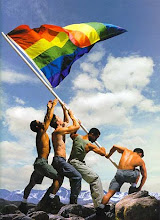Thursday, December 30, 2010
The Graying Of Our Leaders
Thursday, December 30, 2010
The Graying Of Our Leaders
Posted by John Aravosis (DC) at 12/30/2010 01:40:00 PM
From David Mixner:
In the Bible in Palms 71:18 there is a verse that says, "When I am old and gray, do not forsake me..."
The LGBT community is about to lose their tribal leaders, elders and generational history without even a peep. In addition, our collective soul might be scarred for ignoring the plight and needs of those whose sacrifice made it possible for today's generation. Most will never even know or enjoy the rights that they fought so hard for you to celebrate today. They couldn't adopt children, run for office or serve in the military. Often they were institutionalized or forced to live lives of lies and fear.
The baby boom generation of LGBT citizens is the one that spans our history from the oppressive 50's, to the transitional 60's, the liberating 70's, the plague ridden 80's and the beginning of hope in the 1990's. A good deal of the male population of those times already passed in the prime of their youth from HIV/AIDS. Some of the most remarkable women LGBT leaders came to power in that time. Epic battles and tragic stories are waiting to be recorded and told to future generations.
The LGBT community must acknowledge that this generation of LGBT baby boomers is getting old in a time with few services to meet their needs as LGBT seniors. Often they are in smaller and smaller living units, scraping by with little food, limited access to healthcare and almost no living facilities to share with other senior LGBT citizens. The few gay men that are still alive after the AIDS onslaught have few or no peers to share their senior years since the disease wiped out so many of their friends. Like it or not, what remains from the pandemic is an epidemic of loneliness among our seniors.
The Graying Of Our Leaders
Posted by John Aravosis (DC) at 12/30/2010 01:40:00 PM
From David Mixner:
In the Bible in Palms 71:18 there is a verse that says, "When I am old and gray, do not forsake me..."
The LGBT community is about to lose their tribal leaders, elders and generational history without even a peep. In addition, our collective soul might be scarred for ignoring the plight and needs of those whose sacrifice made it possible for today's generation. Most will never even know or enjoy the rights that they fought so hard for you to celebrate today. They couldn't adopt children, run for office or serve in the military. Often they were institutionalized or forced to live lives of lies and fear.
The baby boom generation of LGBT citizens is the one that spans our history from the oppressive 50's, to the transitional 60's, the liberating 70's, the plague ridden 80's and the beginning of hope in the 1990's. A good deal of the male population of those times already passed in the prime of their youth from HIV/AIDS. Some of the most remarkable women LGBT leaders came to power in that time. Epic battles and tragic stories are waiting to be recorded and told to future generations.
The LGBT community must acknowledge that this generation of LGBT baby boomers is getting old in a time with few services to meet their needs as LGBT seniors. Often they are in smaller and smaller living units, scraping by with little food, limited access to healthcare and almost no living facilities to share with other senior LGBT citizens. The few gay men that are still alive after the AIDS onslaught have few or no peers to share their senior years since the disease wiped out so many of their friends. Like it or not, what remains from the pandemic is an epidemic of loneliness among our seniors.
Subscribe to:
Post Comments (Atom)










No comments:
Post a Comment